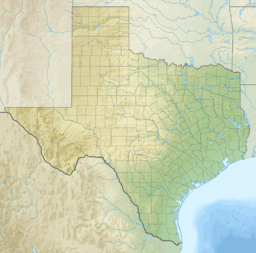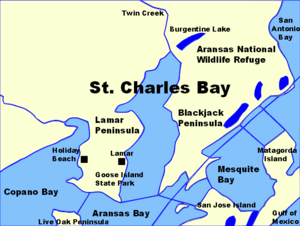St. Charles Bay facts for kids
Quick facts for kids St. Charles Bay |
|
|---|---|
| Location | Texas Gulf Coast |
| Coordinates | 28°11′27″N 96°56′29″W / 28.190967°N 96.941299°W |
| River sources | Cavasso Creek |
| Ocean/sea sources | Gulf of Mexico |
| Basin countries | United States |
| Settlements | Lamar, Texas |
St. Charles Bay is a beautiful inlet of Aransas Bay in Aransas County, Texas. It's like a calm arm of the bigger bay, with the Lamar peninsula on its west side and the Blackjack peninsula on its east. This bay is super important for nature, especially for the rare whooping crane. It's also a fantastic spot for watching birds and fishing.
Along the shores of St. Charles Bay, you'll find Goose Island State Park and the Aransas National Wildlife Refuge. These places bring nature lovers here all year long! Long ago, the Karankawa Indians used the bay for hunting. But no big towns were ever built right on its shores.
The small community of Lamar is the only main place right next to the bay. The cities of Rockport and Fulton are just a few miles away. People often think of St. Charles Bay as part of the Rockport-Fulton area. The bay is about 150 miles (240 km) southeast of San Antonio and about 40 miles (64 km) northeast of Corpus Christi.
Contents
History of St. Charles Bay
St. Charles Bay was home to the Karankawa Indians before Europeans arrived. The Spanish called it "Laguna del Bergantine," which means "Lagoon of the Brigantine" (a type of ship). This name likely led to Burgentine Lake, which is at the top of the bay.
The name came from a Spanish ship in 1818. This ship was carrying money to Texas to pay soldiers. A storm in Aransas Bay pushed the ship into St. Charles Bay. It landed in a creek at the bay's end. People say the ship was left in the nearby fields. Later, settlers used parts of it to build their homes.
Lamar: A Historic Settlement
The first main town on St. Charles Bay was Lamar. James W. Byrne started it in 1839. The town was named after Mirabeau B. Lamar. He had become the President of the Republic of Texas the year before. The settlers wanted Lamar to be a rival to Aransas City, a town nearby.
After a customs office moved from Aransas City to Lamar, Aransas City became less important. Lamar then grew into a busy port and a place that made salt. During the American Civil War, the Union army attacked and destroyed Lamar. Only the remains of a church and a few homes were left.
But the town was rebuilt soon after! By 1915, Lamar had a post office, a school, a hotel, and many homes. By 1970, about 150 people lived there. By 2000, the population grew to 1,600 residents. Today, Lamar is still a small community in Aransas County.
Exploring St. Charles Bay's Geography
St. Charles Bay stretches from south to north. It sits on the Texas Coastal Plain between the Lamar and Blackjack peninsulas. The bay opens into Aransas Bay between Goose Island and Blackjack Point. But islands and reefs almost block this opening.
North of Blackjack Point is an area called the East Pocket. This forms a curve at the tip of the Blackjack peninsula. Beyond the East Pocket are muddy areas that are part of the Aransas National Wildlife Refuge. Further north, past Bird Point, the shore continues past the La Punta Windmill.
Even further north, past a big swamp, Egg Point sticks out into the bay. Above it, an inlet forms the Bill Mott Bayou. After more swamps, Little Devil Bayou and Big Devil Bayou are formed. Indian Head Point separates them. Past Mille Dietrich Point, you'll find the McHubb Windmill and Bayou. Here, the bay gets narrower.
The very northern tip of the bay meets the small Twin Creek. A narrow strip of marshland and a dam separate St. Charles Bay from Burgentine Lake. This lake continues to the northeast and is fed by Burgentine Creek. Past Twin Creek, the shore curves southwest to a small opening. This forms the mouth of Salt Creek.
Further south, the shore is mostly marshland. Then you reach the rather large mouth of Cavasso Creek. From there, the shore goes straight southeast to Big Sharp Point. You can see a gas well in the bay from here. South of Big Sharp Point is Little Sharp Point, which is on the edge of a swamp.
From this point, the shore curves southwest to another swamp. A lagoon is located further inland. South of this is the famous "Big Tree" in Goose Island State Park. Further south are several piers that stick into the bay. Below them, Halls Point is formed. Directly south of Halls Point is Goose Island, where the bay meets Aransas Bay again.
Wildlife and Ecosystem of St. Charles Bay
St. Charles Bay is home to about 300 different kinds of birds! Bird watchers love to visit between November and March. This is when many birds spend the winter near the bay.
The Endangered Whooping Crane
The most special bird to see is the endangered whooping crane. It's the biggest bird in North America. Only a few hundred of these birds are left, and three families live on St. Charles Bay. This bird was almost gone in the early 1900s. There were only two groups left between Canada and Texas.
Their numbers grew after the Aransas Migratory Waterfowl Refuge was created in 1937. The government bought land for the refuge using money from special stamps. This refuge later became the Aransas National Wildlife Refuge. Whooping cranes are also protected by Goose Island State Park. This park was started by Texas in 1931.
Other Amazing Birds and Animals
Other birds that visit the bay include the sandhill crane, American white pelican, brown pelican, roseate spoonbill, great blue heron, and Canada goose. Blue crabs and other shellfish help feed the birds.
Thirty-seven types of mammals live on the Blackjack peninsula. These include white-tailed deer, nine-banded armadillos, and collared peccaries (which look like small wild pigs). The spotted seatrout and redfish are common fish in the bay. Trout usually live in deeper water. Redfish live in shallow water, and you can sometimes see their tail fins sticking out during summer and fall.
The bay also has a healthy number of American alligators. They live in shallow waters. Signs warn visitors to be careful around them.
Industry and Tourism in St. Charles Bay
In the 1800s, people dug salt evaporation ponds in the marshy areas around the bay. They made salt for food and to preserve meat. Today, there isn't much industry around St. Charles Bay. This is because it's located between Goose Island State Park and the Aransas National Wildlife Refuge.
No big factories are on the bay's shore. But there are a few gas and oil wells. The Continental Oil Company is allowed to get oil and gas from the Aransas National Wildlife Refuge. This was part of the deal when the land was bought.
Goose Island State Park has piers and campgrounds facing the bay. These encourage people to visit. The privately owned St. Charles Bay Hunting Club is also in this area. It allows hunting, boating, and fishing on the bay. The club also works to protect the bay's ecosystem.
The calm winds here are great for kayaking and wade fishing (fishing while standing in the water). However, boating can be tricky because the bay is generally shallow. It also has many oyster reefs. Shellfish can be harvested throughout the bay. But shrimping is not allowed. This is because St. Charles Bay is considered a "nursery bay," a special place where young marine life grows.



